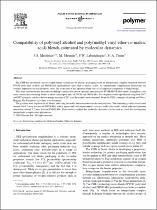 ResearchSpace
ResearchSpace
Compatibility of polyvinyl alcohol and poly(methyl vinyl ether-co-maleic acid) blends estimated by molecular dynamics
JavaScript is disabled for your browser. Some features of this site may not work without it.
- ResearchSpace
- →
- Research Publications/Outputs
- →
- Journal Articles
- →
- View Item
| dc.contributor.author |
Moolman, FS

|
en_US |
| dc.contributor.author |
Meunier, M

|
en_US |
| dc.contributor.author |
Labuschagne, Philip W

|
en_US |
| dc.contributor.author |
Truter, PA

|
en_US |
| dc.date.accessioned | 2007-02-06T12:55:27Z | en_US |
| dc.date.accessioned | 2007-06-07T10:08:40Z | |
| dc.date.available | 2007-02-06T12:55:27Z | en_US |
| dc.date.available | 2007-06-07T10:08:40Z | |
| dc.date.issued | 2005-07-25 | en_US |
| dc.identifier.citation | Moolman, F.A, et al. 2005. Compatibility of polyvinyl alcohol and poly(methyl vinyl ether-co-maleic acid) blends estimated by molecular dynamics. Polymer, vol. 46(16), pp 6192-6200 | en_US |
| dc.identifier.issn | 0032-3861 | en_US |
| dc.identifier.uri | http://hdl.handle.net/10204/1536 | en_US |
| dc.identifier.uri | http://hdl.handle.net/10204/1536 | |
| dc.description.abstract | The CSIR has developed a novel oxygen barrier technology for plastics packaging based on interpolymer complex formation between PVOH (polyvinyl alcohol) and PMVE-MA (poly(methyl vinyl ether-co-maleic acid)). As interpolymer complexation interactions are strongly dependent on stoichiometric ratios, the estimation of the optimum blend ratio is an important component of blend design. This study used molecular dynamics modelling to predict the ratio of optimum interaction for PVOH: PMVE-MA blends. Amorphous cells were constructed containing blends of short-chain repeat units of PVOH and PMVE-MA. The oligomers were equilibrated using both NVT and NPT dynamics and the cohesive energy densities (CED's) of the models were computed. From the CED's, energies of mixing and Flory-Huggins Chi Parameter (chi) values were estimated. The chi-values were negative for all blends, indicating favourable interaction between the two polymers. The minimum chi-values were found around 0.6-0.7 mass fraction of PMVE-MA, which agrees well with experimental viscosity results (this work), which indicated optimum interaction around 0.7 mass fraction PMVE-MA. These results confirm that molecular dynamics can be used as a tool for investigating interpolymer complexation phenomena. | en_US |
| dc.format.extent | 351307 bytes | en_US |
| dc.format.mimetype | application/pdf | en_US |
| dc.language.iso | en | en_US |
| dc.publisher | Elsevier Science Ltd | en_US |
| dc.rights | Copyright: 2005 Elsevier Science Ltd | en_US |
| dc.subject | Interpolymer complexation | en_US |
| dc.subject | Molecular dynamics | en_US |
| dc.subject | Soft drinks packaging | en_US |
| dc.subject | PET | en_US |
| dc.subject | Polyethylene terephthalate | en_US |
| dc.subject | Polymer sciences | en_US |
| dc.title | Compatibility of polyvinyl alcohol and poly(methyl vinyl ether-co-maleic acid) blends estimated by molecular dynamics | en_US |
| dc.type | Article | en_US |
| dc.identifier.apacitation | Moolman, F., Meunier, M., Labuschagne, P. W., & Truter, P. (2005). Compatibility of polyvinyl alcohol and poly(methyl vinyl ether-co-maleic acid) blends estimated by molecular dynamics. http://hdl.handle.net/10204/1536 | en_ZA |
| dc.identifier.chicagocitation | Moolman, FS, M Meunier, Philip W Labuschagne, and PA Truter "Compatibility of polyvinyl alcohol and poly(methyl vinyl ether-co-maleic acid) blends estimated by molecular dynamics." (2005) http://hdl.handle.net/10204/1536 | en_ZA |
| dc.identifier.vancouvercitation | Moolman F, Meunier M, Labuschagne PW, Truter P. Compatibility of polyvinyl alcohol and poly(methyl vinyl ether-co-maleic acid) blends estimated by molecular dynamics. 2005; http://hdl.handle.net/10204/1536. | en_ZA |
| dc.identifier.ris | TY - Article AU - Moolman, FS AU - Meunier, M AU - Labuschagne, Philip W AU - Truter, PA AB - The CSIR has developed a novel oxygen barrier technology for plastics packaging based on interpolymer complex formation between PVOH (polyvinyl alcohol) and PMVE-MA (poly(methyl vinyl ether-co-maleic acid)). As interpolymer complexation interactions are strongly dependent on stoichiometric ratios, the estimation of the optimum blend ratio is an important component of blend design. This study used molecular dynamics modelling to predict the ratio of optimum interaction for PVOH: PMVE-MA blends. Amorphous cells were constructed containing blends of short-chain repeat units of PVOH and PMVE-MA. The oligomers were equilibrated using both NVT and NPT dynamics and the cohesive energy densities (CED's) of the models were computed. From the CED's, energies of mixing and Flory-Huggins Chi Parameter (chi) values were estimated. The chi-values were negative for all blends, indicating favourable interaction between the two polymers. The minimum chi-values were found around 0.6-0.7 mass fraction of PMVE-MA, which agrees well with experimental viscosity results (this work), which indicated optimum interaction around 0.7 mass fraction PMVE-MA. These results confirm that molecular dynamics can be used as a tool for investigating interpolymer complexation phenomena. DA - 2005-07-25 DB - ResearchSpace DP - CSIR KW - Interpolymer complexation KW - Molecular dynamics KW - Soft drinks packaging KW - PET KW - Polyethylene terephthalate KW - Polymer sciences LK - https://researchspace.csir.co.za PY - 2005 SM - 0032-3861 T1 - Compatibility of polyvinyl alcohol and poly(methyl vinyl ether-co-maleic acid) blends estimated by molecular dynamics TI - Compatibility of polyvinyl alcohol and poly(methyl vinyl ether-co-maleic acid) blends estimated by molecular dynamics UR - http://hdl.handle.net/10204/1536 ER - | en_ZA |





